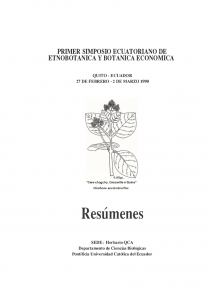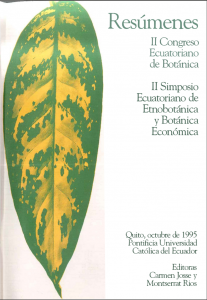Publications for sale
applications, challenges, and perspectives
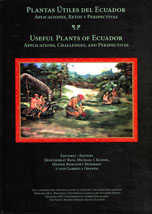
This book presents 1,191 useful plant species, promoting the advancement of health care and environmental protection through a consistent knowledge of nature. The research was conducted over the course of 18 years. During which time the authors carried out a theoretical and a practical study of the plant resources contained herein, which has facilitated their identification, rescue, and use based assessment. In particular, this study has focused on the indigenous perception, denomination and ordering of plant resources utilized as food, medicine, clothing, tools, rites, poisons, ornaments, housing and craft construction, in addition to those utilized in many other fashions.
Editors
- Montserrat Rios
- Michael J. Koziol
- Henrik Borgtoft Pedersen
- Gabriela Granda
Comments
Points of sale
- Librería Internacional Libri Mundi
- Missouri Botanical Garden
- Librería Mr. Books
- Wayruro centro de comercio justo
- Librería Tecnilibro (teléfonos: 593-2-2546222, 3214598, 2551081)
- Librería Studium
Av. de los Shyris y Bélgica
Quito
Teléfono: 3800 925 / 3800 933
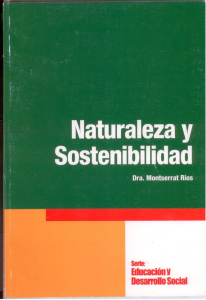
This book encourages sustainable development between human and environment, promoting with several ideas and practices a new life style. While the content discusses a plethora of countries, it primary regional focus is Ecuador, whose geographical locality has resulted in an extreme abundance of biological diversity. In a didactic manner, this study presents an analysis of the most important components of nature and how the conservation of these components can improve living standards of humanity, respecting and caring the planet.
Authors
- Montserrat Rios
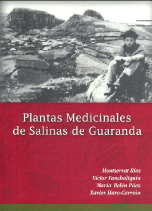
This book constitutes a valuable contribution to the rescue effort of ancestral wisdom because it demonstrates the relationship that exists between the indigenous community of the salineritos and nature. The investigation reports on 21 medicinal plant species, presenting for each one the vernacular name, scientific name, botanical family, origin, cultural state, spatial distribution, temporal availability, uses, morphological characteristics, useful plant organ, mode of preparation, consumption form, propagation data, and warnings related with its consumption.
Authors
- Montserrat Rios
- Víctor Yachaliquín
- María Belén Páez
- Xavier Haro-Carrión
saberes y prácticas
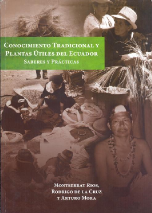
This book attempts to educate the reader regarding conceptual elements linked to socio-ecological aspects of ancestral wisdom of sustainable plant use. In its three chapters, this book presents different themes related to the conservation of natural areas; criteria for a just and equal distribution of the benefits that come with obtaining ancestral wisdom and useful plants; indicators of sustainable management of wild plants with potential use; and a novel proposal of a legal frame to protect traditional wisdom.
Authors
- Montserrat Rios
- Rodrigo de la Cruz
- Arturo Mora
Courtesy publications
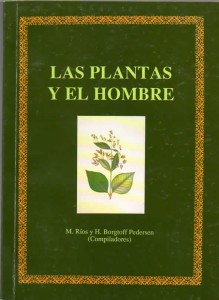
The book documents in 35 articles the relationship between men and plants, presenting a new approximation of diversified and sustainable natural vegetation use in Ecuador and other Latin American countries. This work is divided in five chapters: Useful plants’ conservation and management; Regional Ethnobotany; Medicinal plants; and Ethnobotany and its aplications.
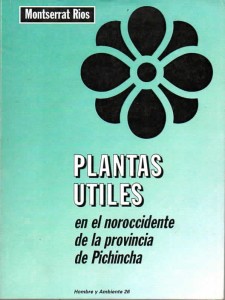
This book compiles data of an investigation of 101 vegetative species used by the mestizo settlers of the Caserío Álvaro Pérez Intriago, who constitute one of the few isolated communities living in a marginal area and conserving traditional plant use. Data from the 101 taxa are compared with other ethnobotany studies, elucidating that 14 of these species are used by the Siona-Secoya, ten by the Kichwa and five by the Shuar in Ecuador, 18 by the Tukuna in the Colombian Amazon and seven by the Chácobo in Bolivia.
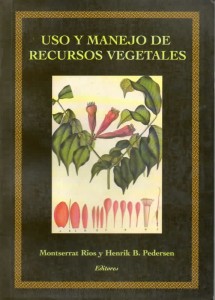
This book presents in 22 articles the relationship between human societies and plant resources, focusing on the investigations conducted in Ecuador and other Latin American countries. This study is divided in four chapters: Sustainable management and conservation, Ethnobotany and intellectual property rights, Food plants, and Medicinal and toxic plants.
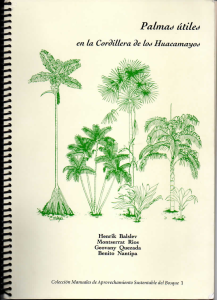
This book documented how the Kichwa community of Santa Rita utilizes 22 species of palms found in their settlement and surrounding area in human and animal consumption, in the making of roofs, pillars, handmade ornaments, brooms, medicines, and in religious ceremonies. This publication is a contribution to the preservation effort of this community’s ancestral wisdom related to biodiversity, which is especially important for their young people responsible for conserving the legacy.

The book revealed the importance of twelve plant species from secondary succession “capoeira” in the social and ecological history of Brazilian Amazon by revealing their nutritional, medicinal, textile, toxicological, ornamental, tannin sources, and ritual potential. This work explains how small farmers from the Benjamín Constant community, located in the Bragantina Region of the Pará state at the Brazilian Amazon recognize useful plant resources as well as the four ecotones of ecological succession where they are found, each one is being classified and named according to their age.
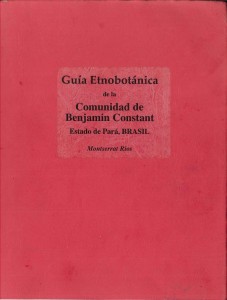
The ethnobotany guide of the Benjamin Constant community, small farmers who settled at planalto coast of Brazil, represents a Micro-Herbaria of secondary succession plants in Amazonia. This has become a valuable visual tool for students and scientists. The herbarium specimen scans belong to the catalogue collections of The Field Museum (F), The New York Botanical Garden (NY) and Missouri Botanical Garden (MO). The manual reports on 130 useful plant species including 95 genera and 53 families, distributed at “capoeiras” for six months up to 150 years. On each sheet the species is registered with its vernacular name, scientific name and family, alongside its image which allows for easier recognition of the specimens at herbaria and in the field.
los recursos genéticos, las especies y las funciones ecosistémicas en el Ecuador

The book is a compilation of 29 research papers from national and foreign specialists presented in the “Aprovechamiento Económico del Bioconocimiento, los Recursos Genéticos, las Especies y las Funciones Ecosistémicas en el Ecuador” event (Economic Use of Bio-knowledge, Genetic Resources, Species and the Environmental Functions in Ecuador); this event was organized by the Ministry of Heritage Coordination, the Commission of Biodiversity and Natural Resources of the National Assembly, the Legislative School of the National Assembly, and the Institute of Higher National Education. Through this publication, The Ministry addresses the need to strengthen dialogue between traditional wisdom and western science to have the country advance a research program that allows for a sovereign and equitable use of biodiversity.
plantas , salud y bienestar en la Amazonía del Ecuador

This book examines the cultural and natural heritage of the Ecuadorian Amazon, particularly in the territory of the Waorani indigenous nationality and their natural surroundings. The content herein represents a tangible collaboration between indigenous collaborators, national specialists, and foreign scientists, proving the possibility of intercultural multidisciplinary and transdisciplinary cooperation. The Waorani people lived isolated until the 50’s and continue conserving a highly depending of the tropical rainforest.

This book is a compendium of experiences in the Napo Province during 2008-2013, being generated through the advancement of participatory governance of natural resources by the program “Gestión Sostenible de los Recursos Naturales” (GESOREN) of the German Federal Enterprise for International Cooperation (GIZ) with “Ministerio del Ambiente del Ecuador” and the “Gobierno Autónomo Descentralizado Provincial de Napo”, among other actors from the public and private sectors. This enterprise was established through the creation of five management platforms known locally as: “Cacao and Chocolate Table”, “Tourism Table”, “Forestry Table”, “Clean Naranjilla Table”, and the “Corredor de Conservación para el Buen Vivir at the Quijos valley”.
Studies in Colombia and Peru
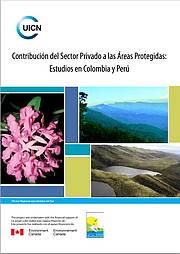
This book illustrates the importance of contributions from the private sector to protected areas through two case studies, one in Colombia with the “Agua Somos” and the other in Peru with the “Parque Nacional Cordillera Azul”. The content shows the success that can be achieved with financial sustainability through its analysis of two case studies exemplifying the benefits derived from long run legal frames, governance, financial instruments, sources of financing, and improved quality of life in local populations. The management model of the two initiatives receives national, regional, and global acknowledgment for exemplifying the potential of environmental services.
Access to genetic resources and benefit sharing
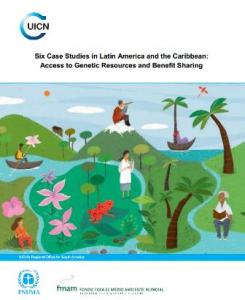
The book is the first publication of the Project UICN-PNUMA/GEF-ABS-LAC, and it aims to improve the knowledgebase regarding access to genetic resources and distribution of benefits between the different actors and those interested in the region through the exchange of experiences. The content presents lessons learnt on the challenge to oversee the access to genetic resources, as well as the distribution of monetary and nonmonetary benefits in six countries.
Support tools for implementation
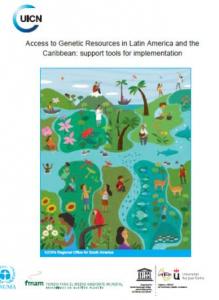
This book is the fourth and last publication of the Project UICN-PNUMA/GEF-ABS-LAC, which contributes a series of key tools that have been prepared and systematized during their course and execution. The content contributes with a compilation of conduct codes and also better practices regarding access to genetic resources and benefits distribution, promoting their application in the region.
Research, commercialization and indigenous worldview
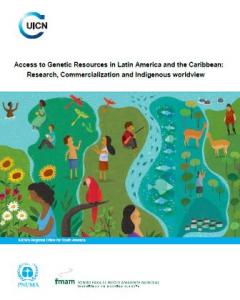
The book is the second publication of the Project UICN-PNUMA/GEF-ABS-LAC, which analyzes various study cases that illustrate the existent interrelation between investigation, commercialization, and indigenous cosmovision with biodiversity. The content points at the importance to improve the local reach of the different actors of the region and to sensitize their knowledge, presenting an exchange of experiences, as well as the analysis of critical themes linked to access to genetic resources and benefits distribution.
Implementation of the Nagoya protocol at a national level
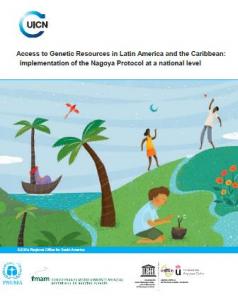
The book is the third publication of the Project UICN-PNUMA/GEF-ABS-LAC that focuses on defining the critical elements that have to be considered when developing or actualizing the national frames of access to genetic resources and benefits distribution. The content shows national and international experiences, as well as the direct influence that was exerted by some national regulations to inspire the majority of the elements and obligations of the Nagoya Protocol.
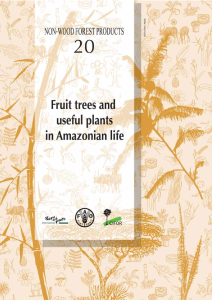
The book integrates the ancestral wisdom of traditional populations about useful plants of the tropical forest in the Brazilian Amazon, promoting the understanding of nature with sensitive and deep feeling. This investigation indorses equality, equanimity, and effectiveness in science, recognizing that every person can contribute to scientific knowledge and considering the inhabitants of the Amazonia at the same level of scientists. During the research 90 international experts shared their experience in lay terms and demonstrated that science can be presented in innovative ways.
